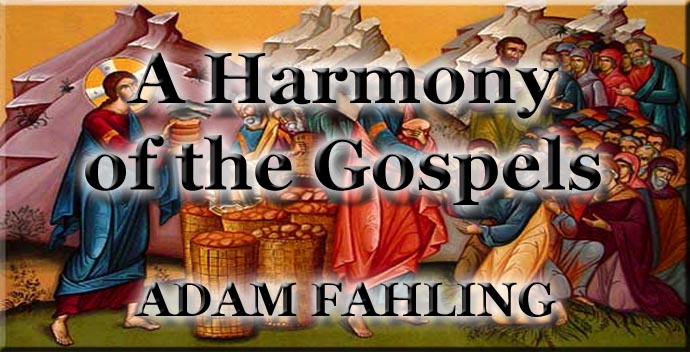
A Harmony of the Gospels
By Adam Fahling
Preface
|
Many harmonies of the Gospels have been written since ancient times. They are almost as old as the Gospels themselves. In the earliest life of Christ ever compiled, the Diatessaron of Tatian, which was written a bare century after the appearance of John, the author has blended together the narrative of the Gospels into what he considered the probable course of events in the earthly life of Christ. Thus ingenious arrangements or harmonies—a composite of the Gospel account, a classification of sections, a presentation of the separate events in parallel account, and the like—have continued down to our day. And none of them are quite satisfactory. But this does not mean that harmonies of the Gospels are without purpose or value. Theological students in colleges and seminaries, teachers and pupils in Christian schools, pastors preparing their sermons, and intelligent readers of the Bible, will derive great benefit for their own studies from the result of another’s investigation. One who reads a harmony of the Gospels for the first time is amazed at the flood of light that flashes from the parallel and progressive records of the life of Christ. However, in constructing a harmony the difficulty lies in the attempt to group together or to arrange the material in a satisfactory manner. In spite of the ingenious arrangements of some older harmonists it seems that transpositions cannot be avoided. The present writer made the same attempt in which neither time, thought, study, labor, patience, nor paper were spared for the purpose of constructing a harmony which leaves each Gospel in its own undisturbed sequence, but he was forced to give it up. It is assumed that most readers of this book are acquainted with the subjects of authorship, canonicity, and inspiration of the Gospels. They need not detain us here. Neither do we propose to enter into the realms of higher criticism, the synoptic problem, and kindred matter. However, many readers may be interested in the principles upon which this arrangement is based. As a result of his studies the present writer has almost been compelled to be guided by a number of principles or points. In the first place, the Synoptists wrote independently of each other. This statement is not made in ignorance of contradictory claims, but with the conviction that these claims cannot be successfully maintained. In making close comparisons, especially also of the original text, the evidence of independence seems to be overwhelming. In the next place, as a basic rule the natural order of each Gospel is to be observed throughout. Unless otherwise stated, it is no more than fair that the order or sequence in any historical or biographical work is to be accepted as given. However, thirdly, it seems that large portions of Matthew, and also sections of Luke, are topical rather than strictly chronological. A close comparison forces one to this conclusion, unless a confusing number of repetitions for apparently the same event is to be accepted. And therefore, in the fourth place, unless expressly stated, a number of transpositions or a shifting of material must be allowed. Moreover, a consideration of the probable purpose for which certain events are grouped, or of the circumstances in which they have been introduced, is to be permitted. But, finally, all transpositions from the natural order of the respective Gospels are to be made only where absolutely necessary and after all other attempts at harmonization have failed. And now a few more words on externals and the physical appearance of this work before the reader is invited to turn the page. This harmony is based on the King James version of the English Bible. In spite of the need and existence of modern revisions it seems that the old King James version is still the most popular for pulpit and class-room work. A distinctive type has been employed for the individual Gospels. It is hoped that after a little reading, already from the appearance of the type, the student will readily see from which particular Gospel the section or paragraph was taken. The text of the Gospels has been broken up into small sections so as to place the entire material of any event before the reader for easy comparison, and, wherever possible, on the open page. There should be little need of turning the page. With but few exceptions each section ends on the page on which it begins. On account of the nature of the material the task has been difficult and the work exacting. Acknowledgments are due to the publishers for their fine cooperation, the typesetters, composers, and proofreaders for their more than usually required work and attention, and to a good friend and brother, the Reverend Lawson Knight, for reading the final proof. If this work has no other distinction it is hoped that, at least, a readable Harmony of the Gospels—probably the first—has been produced. It will also serve as a book of reference and a text, completely printed out, upon which the author’s Life of Christ is based. May this book lead many into a deeper study of the life and work of Christ! |
||
 |
 |
|
|
||
-
Site Navigation
 Home
Home What's New
What's New Bible
Bible Photos
Photos Hiking
Hiking E-Books
E-Books Genealogy
Genealogy Profile
Free Plug-ins You May Need
Profile
Free Plug-ins You May Need
 Get
Java
Get
Java.png) Get Flash
Get Flash Get
7-Zip
Get
7-Zip Get Acrobat Reader
Get Acrobat Reader Get
TheWORD
Get
TheWORD